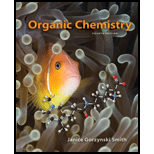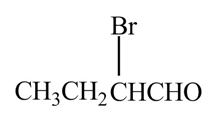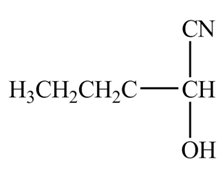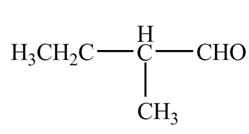
Draw the organic products formed when butanal
a.
b.
c.
d.
e.
(a)
Interpretation: The organic product formed when
Concept introduction: The synthesis of the products relies upon the type of reactants and reagents that are used during the reactions. The energy of a target molecule should be low because it increases the stability of a molecule that results in the formation of products with high yield. The reagents perform numerous functions in reactions like proton abstraction, oxidation, reduction, catalysis, and dehydrogenation.
Answer to Problem 24.48P
The organic product formed when

Explanation of Solution
The chemical equation when

Figure 1
The above equation shows that two equivalents of butanal is treated with
The organic product formed when
(b)
Interpretation: The organic product formed when
Concept introduction: The synthesis of the products relies upon the type of reactants and reagents that are used during the reactions. The energy of a target molecule should be low because it increases the stability of a molecule that results in the formation of products with high yield. The reagents perform numerous functions in reactions like proton abstraction, oxidation, reduction, catalysis, and dehydrogenation.
Answer to Problem 24.48P
The organic product formed when

Explanation of Solution
The chemical equation when

Figure 2
The above equation shows that butanal is treated with
The organic product formed when
(c)
Interpretation: The organic product formed when
Concept introduction: The synthesis of the products relies upon the type of reactants and reagents that are used during the reactions. The energy of a target molecule should be low because it increases the stability of a molecule that results in the formation of products with high yield. The reagents perform numerous functions in reactions like proton abstraction, oxidation, reduction, catalysis, and dehydrogenation.
Answer to Problem 24.48P
The organic product formed when

Explanation of Solution
The chemical equation when

Figure 3
The above equation shows that butanal is treated with LDA,
The organic product formed when
(d)
Interpretation: The organic product formed when
Concept introduction: The synthesis of the products relies upon the type of reactants and reagents that are used during the reactions. The energy of a target molecule should be low because it increases the stability of a molecule that results in the formation of products with high yield. The reagents perform numerous functions in reactions like proton abstraction, oxidation, reduction, catalysis, and dehydrogenation.
Answer to Problem 24.48P
The organic product formed when

Explanation of Solution
The chemical equation when

Figure 4
The above equation shows that butanal is treated with
The organic product formed when
(e)
Interpretation: The organic product formed when
Concept introduction: The synthesis of the products relies upon the type of reactants and reagents that are used during the reactions. The energy of a target molecule should be low because it increases the stability of a molecule that results in the formation of products with high yield. The reagents perform numerous functions in reactions like proton abstraction, oxidation, reduction, catalysis, and dehydrogenation.
Answer to Problem 24.48P
The organic product formed when

Explanation of Solution
The chemical equation when

Figure 5
The above equation shows that butanal is treated with
The organic product formed when
(f)
Interpretation: The organic product formed when
Concept introduction: The synthesis of the products relies upon the type of reactants and reagents that are used during the reactions. The energy of a target molecule should be low because it increases the stability of a molecule that results in the formation of products with high yield. The reagents perform numerous functions in reactions like proton abstraction, oxidation, reduction, catalysis, and dehydrogenation.
Answer to Problem 24.48P
The organic product formed when
Explanation of Solution
The chemical equation when
The above equation shows that butanal is treated with
The organic product formed when
(g)
Interpretation: The organic product formed when
Concept introduction: The synthesis of the products relies upon the type of reactants and reagents that are used during the reactions. The energy of a target molecule should be low because it increases the stability of a molecule that results in the formation of products with high yield. The reagents perform numerous functions in reactions like proton abstraction, oxidation, reduction, catalysis, and dehydrogenation.
Answer to Problem 24.48P
The organic product does not form when butanal is treated with the given reagent.
Explanation of Solution
The chemical equation when
The above equation shows that butanal does not form any product when it is treated with hydrogen in the presence of
The reaction does not take place when butanal is treated with the given reagent.
(h)
Interpretation: The organic product formed when
Concept introduction: The synthesis of the products relies upon the type of reactants and reagents that are used during the reactions. The energy of a target molecule should be low because it increases the stability of a molecule that results in the formation of products with high yield. The reagents perform numerous functions in reactions like proton abstraction, oxidation, reduction, catalysis, and dehydrogenation.
Answer to Problem 24.48P
The organic product formed when

Explanation of Solution
The chemical equation when

Figure 6
The above equation shows that butanal is treated with
The organic product formed when
(i)
Interpretation: The product formed when
Concept introduction: The synthesis of the products relies upon the type of reactants and reagents that are used during the reactions. The energy of a target molecule should be low because it increases the stability of a molecule that results in the formation of products with high yield. The reagents perform numerous functions in reactions like proton abstraction, oxidation, reduction, catalysis, and dehydrogenation.
Answer to Problem 24.48P
The organic product formed when
Explanation of Solution
The chemical equation when
The above equation shows that butanalreacts with
The organic product formed when
(j)
Interpretation: The organic product formed when
Concept introduction: The synthesis of the products relies upon the type of reactants and reagents that are used during the reactions. The energy of a target molecule should be low because it increases the stability of a molecule that results in the formation of products with high yield. The reagents perform numerous functions in reactions like proton abstraction, oxidation, reduction, catalysis, and dehydrogenation.
Answer to Problem 24.48P
The organic product formed when
Explanation of Solution
The chemical equation when
The above equation shows that butanal reacts with
The organic product formed when
(k)
Interpretation: The organic product formed when
Concept introduction: The synthesis of the products relies upon the type of reactants and reagents that are used during the reactions. The energy of a target molecule should be low because it increases the stability of a molecule that results in the formation of products with high yield. The reagents perform numerous functions in reactions like proton abstraction, oxidation, reduction, catalysis, and dehydrogenation.
Answer to Problem 24.48P
The organic product formed when
Explanation of Solution
The chemical equation when
The above equation shows that butanal reacts with
The organic product formed when
(l)
Interpretation: The organic product formed when
Concept introduction: The synthesis of the products relies upon the type of reactants and reagents that are used during the reactions. The energy of a target molecule should be low because it increases the stability of a molecule that results in the formation of products with high yield. The reagents perform numerous functions in reactions like proton abstraction, oxidation, reduction, catalysis, and dehydrogenation.
Answer to Problem 24.48P
The organic product formed when

Explanation of Solution
The chemical equation when

Figure 7
The above equation shows that butanal reacts with
The organic product formed when
(m)
Interpretation: The organic product formed when
Concept introduction: The synthesis of the products relies upon the type of reactants and reagents that are used during the reactions. The energy of a target molecule should be low because it increases the stability of a molecule that results in the formation of products with high yield. The reagents perform numerous functions in reactions like proton abstraction, oxidation, reduction, catalysis, and dehydrogenation.
Answer to Problem 24.48P
The organic product formed when
Explanation of Solution
The chemical equation when
Figure 8
The above equation shows that butanal reacts with
The organic product formed when
(n)
Interpretation: The organic product formed when
Concept introduction: The synthesis of the products relies upon the type of reactants and reagents that are used during the reactions. The energy of a target molecule should be low because it increases the stability of a molecule that results in the formation of products with high yield. The reagents perform numerous functions in reactions like proton abstraction, oxidation, reduction, catalysis, and dehydrogenation.
Answer to Problem 24.48P
The organic product formed when

Explanation of Solution
The chemical equation when

Figure 8
The above equation shows that butanal reacts with
The organic product formed when
(o)
Interpretation: The organic product formed when
Concept introduction: The synthesis of the products relies upon the type of reactants and reagents that are used during the reactions. The energy of a target molecule should be low because it increases the stability of a molecule that results in the formation of products with high yield. The reagents perform numerous functions in reactions like proton abstraction, oxidation, reduction, catalysis, and dehydrogenation.
Answer to Problem 24.48P
The organic product formed when

Explanation of Solution
The chemical equation when

Figure 9
The above equation shows that butanal reacts with LDA in the presence of
The organic product formed when
Want to see more full solutions like this?
Chapter 24 Solutions
Connect Access Card For Organic Chemistry
- 3. a. What is the chemical structure of benzoic acid, circle functional groups different than alkane,alkene, alkyne? b. Is it polar or nonpolar? _______________________ c. What is its water solubility in g/L? __________________________arrow_forwardwhich reagents complete the reaction?arrow_forwardDraw the products formed when D-altrose is treated with each reagent. a. (CH3)2CHOH, HCl b. NaBH4, CH3OH c. Br2, H2O d. HNO3, H2O e. [1] NH2OH; [2] (CH3CO)2O, NaOCOCH3; [3] NaOCH3 f. [1] NaCN, HCl; [2] H2, Pd-BaSO4; [3] H3O+ g. CH3I, Ag2O h. C6H5CH2NH2, mild H+arrow_forward
- 1. What are the characteristics of a positive tollens test for adehydes? What is the oxidizing agent in tollens solutions? 2. What is the characteristics of a positive Benedict's test for aldehydes? What is the oxidizing agent in Benedict's solution?arrow_forwardMaltose is a carbohydrate present in malt, the liquid obtained from barley and other grains. Although maltose has numerous functional groups, its reactions are explained by the same principles we have already encountered.a. Label the acetal and hemiacetal carbons.b. What products are formed when maltose is treated with each of these reagents: [1] H3O+; [2] CH3OH and HCl; [3] excess NaH, then excess CH3I?c. Draw the products formed when the compound formed in Reaction [3] of part (b) is treated with aqueous acid.The reactions in parts (b) and (c) are used to determine structural features of carbohydrates like maltose.arrow_forwardDraw the product formed when (CH3)2CHOH is treated with each reagent (a, b and c)arrow_forward
- 1. Carboxylic acid reacts with an alcohol to form: A. Ester and Water B. Ester C. Water D. No reaction 2. The general formula for Carboxylic acids: A. RCOOH B. RCOOR C. RCOR D. RCOH 3. General formula of phenols: * A. ROH B. Ar-OH C. R-SH D. RCOHarrow_forwardDraw the products formed when each alkyl halide is treated with NaCN.arrow_forwardDraw the product resulting from mild oxidation of (a) 2-butanol; (b) 2-methylpropanal; (c) cyclopentanol.arrow_forward

